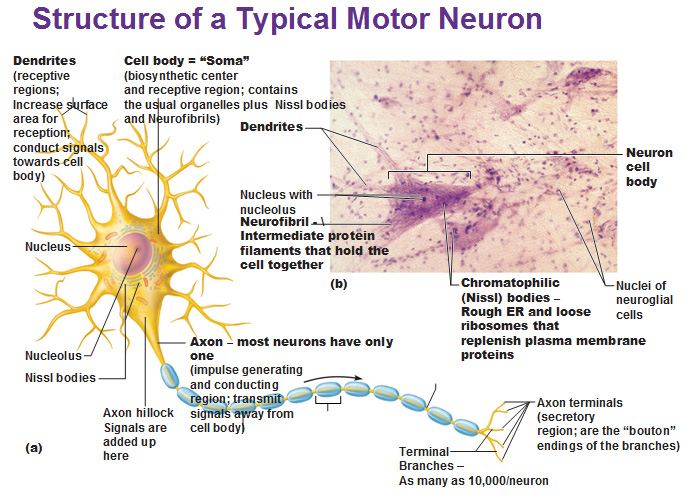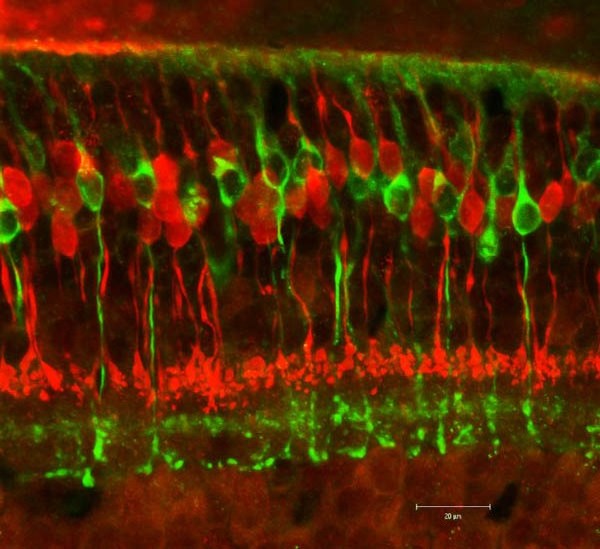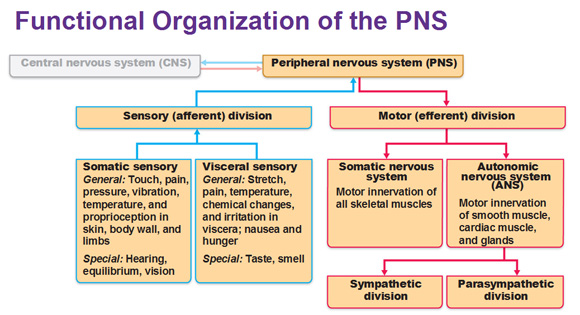Neurons in the Nervous System

Neurons are cells. There are two cells in the body that are not round. Nerve cells and muscle cells are long and skinny and that’s why they are called nerve fibers and muscle fibers. Both of them have the general characteristic of excitability and conductibility (ability to conduct that electrical impulse along that length). Nerve and muscle cells are highly specialized cells in the body. All nerve cells are thinner than a nylon thread and sometimes they are four feet long. The more specialized a cell is, the less often it divides. Nobody worries when you cut your skin because it will grow back just fine. However, nerve and muscle cells are permanent irreplaceable losses and much more serious. What about body builders? They don’t create more muscle cells, their muscle cells hypertrophy (the opposite of atrophy, the muscle cells increase in volume).
Relevant anatomy article: Fundamentals of the Nervous System and Nervous Tissue

Nerve cells shows more variation in shape than any other cell in the body. The cell body is the area where the nucleus is. Coming off the body are these extensions called neuronal processes/extensions: dendrites and axons. Dendrite is the most difficult to define but we could call them detecting stimuli (changes) and we’ll leave it at that. Axons are easier to define and we could say they always terminate into synaptic knobs. The dendrites don’t have terminating knobs at the end of it. The axons are what conduct action potentials away from the cell body. The axon is not an axon because it’s long, it’s an axon because of the existence of synaptic knobs at the axon terminals. When the axon conducts action potentials away from the cell body and the signal goes to the synaptic knob, it’s going to release a neurotransmitter in response to the electrical signal. These neurotransmitters are how information is passed through the nervous system. It is not a flow of electrons (electricity) that is being conducted through like a piece of metal.
This axon also has myelinating cells wrapping around it. If the myelinating cell is covering an interneuron in the CNS, it’s called an oligodendrocyte. If the myelinating cell is wrapped around a nerve cell in the PNS, it’s a Schwann cell. Between the myelinating cells are these gaps called Nodes of Ranvier.

Three General Types of Neurons

“Nerve cells shows more variation in shape than any other cell in the body.”
1. Bipolar: The cell body is where the nucleus is. The branches off the cell body are neuronal processes. How many neuronal processes off the cell body exist off this nerve? Two. Since it has two neuronal processes, it’s labeled a bipolar shaped neuron. This has nothing to do with bipolar disorder (manic depression). How do we label the axons? We know they are axons if they have terminating knobs? The axon is easy to define. The dendrite is harder to define. The books are not consistent with which part of this cell is considered a dendrite so you won’t be given that info. Where is this cell bipolar cell found? It’s found in the retina of our eyes. In fact, during embryonic development, the eyes grow directly right out of the brain.

2. Unipolar. Most sensory neurons have this shape. Whats the cell body? It’s obvious here. How many neuronal processes are coming off the cell body? It’s just one. It bifurcates afterwards but it’s considered to be unipolar before the branch. The axons are easy to define because the axons have the the terminating synaptic knobs. Almost all the books call this a unipolar neuron and some books call it a pseudobipolar nerve.
3. Multipolar. Notice the cell body. It’s got many neuronal processes. Multi means many. It’s easy to recognize the axon, it ends in synaptic knobs. This is a very important nerve because ALL motor neurons have this shape and many interneurons (we will explain interneurons soon).
Three Functional Categories of Neurons
1. Sensory (Afferent) neurons: Send AP (action potentials) to the CNS. They’re sending INFORMATION to the CNS and usually have a unipolar shape. There’s actually two categories of sensory neurons:
1a. Somatic Sensory Neurons. These neurons transmit information from the skin or skeletal muscles to CNS. If you wiggle your toes, you will feel sensations from your skin and skeletal muscles contracting and relaxing. We call these somatic sensory neurons. Interestingly, this information reaches consciousness. Consciousness meaning, your awareness.
1b. Visceral Sensory Neurons. Visceral means internal organ. These neurons transmit information from the internal organs to the CNS. Interestingly, this information doesn’t usually reach consciousness. Can you feel when your gall bladder contracts and releases bile? Can you feel when your pancreas releases pancreatic juice? Can you feel your kidneys filtering fluid? No. There’s information being sent but it’s not reaching consciousness and you’re not aware of it. The only time you’ll feel it is when there is pain because something is wrong.
2. Interneurons: These are neurons located entirely within our CNS and most have a multipolar shape. They are for thinking, memory and decision making. Your CNS is made up of 99.8% of these interneurons. What do we use our brains for? For thinking, memory and making decisions.
3. Motor (Efferent) neurons send action potentials to the effectors. They are causing the organs of our body to DO STUFF. ALL motor neurons have multipolar shapes.
3a. Somatic motor neurons innervate skeletal muscles and are under voluntary control.
3b. Autonomic motor neurons innervate visceral smooth muscle, cardiac muscle, and glands. They are not under voluntary control. For example, try to wiggle your tongue. STOP. Wiggle your tongue again. STOP. We have voluntary control over the tongue, so that means it’s a skeletal muscle. Okay, now speed up your heart. STOP. Speed up your heart. STOP YOUR HEART. Nah, we can’t seem to do that. Okay now activate your sweat glands!!! Sweat, go go go! STOP sweating! We can’t do that. If you can’t do it, it’s an internal organ controlled by an autonomic motor neuron. If I go running, my brain will automatically speed up the heart beat for me and if i generate enough heat, i will sweat, but I can’t do those things voluntarily. (Visceral sensory neurons are to sensory neurons as autonomic motor neurons are to motor neurons.)
Why is our awareness limited to the somatic sensory and somatic motor neurons?
The reason why it’s this way is so we could focus what’s going around us. If you could consciously release bile, control your kidney filter, speed up your heart and reduce your heart, then you can’t do anything all day. “Wanna go out for a movie?” “No I’m busy controlling my internal organs.” We let our brains do it automatically so we could focus in the world around us.
Four functional categories of our nerves
A nerve is like a telephone cable. Inside the cable there are many wires. Well, inside a spinal nerve there are hundreds of thousands of wires and there’s 4 categories of them. Our nerves are what make up our peripheral nervous system.
We have these four types of wires in a nerve cell:
- Somatic sensory neuron (INPUT)
- Visceral sensory neuron (INPUT)
- Somatic motor neuron (OUTPUT)
- Autonomic motor neuron (OUTPUT)
The sensory neurons represent the INPUT signal: What do sensory neurons do? They send information from our body to the CNS. What’s the diff between somatic and visceral? Somatic send from skin and muscle and send to our consciousness. Visceral send from internal organs and don’t reach our consciousness. We don’t just have four wires of each, we have hundreds of thousands of each.
The OUTPUT signal comes from the motor neurons: What do somatic motor neurons command? Skeletal muscles and they are under voluntary control. What do autonomic motor neurons command? Our internal organs, automatically. So these are the functional categories.
Overview of the Nervous System Flowchart

Let’s tie everything together using the graphic above. What is the CNS? The brain and spinal cord. And what do we call the neurons in the brain? Interneurons! What do we use them for? Thinking, memory and decision making.
What is the PNS? These are the cranial nerves and spinal nerves; the nerves that come off the brain and spinal cord. They go out the CNS to the periphery of the body. What’s inside them? Two types of sensory neurons (somatic and visceral) and two types of motor neurons (somatic and autonomic). There are two subcategories of autonomic motor neurons (aka the autonomic nervous system; ANS) called the sympathetic/parasympathetic nervous systems.
There’s information is coming in by the sensory (afferent) division from the PNS, through the CNS, and commands coming out through the motor (efferent) division of the PNS.
And that concludes our introduction to Neurons. Now it’s time to learn about…






